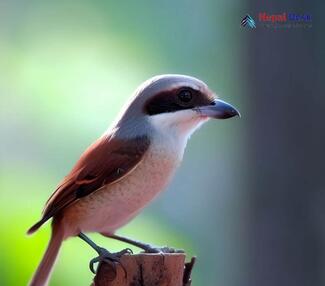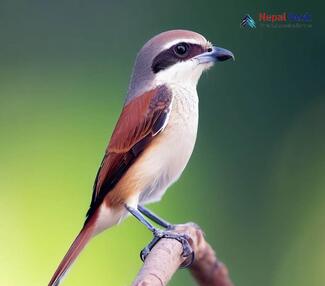Nepal, a land celebrated for its rich wildlife and stunning scenery, hosts an astounding array of bird species. One such captivating bird is the Brown Shrike (Lanius cristatus), a migratory feathered friend often seen in Nepal's birdwatching hotspots during specific seasons. Closely related to the red-backed shrike and isabelline shrike, it mainly calls Asia home. The Latin genus name "Lanius" translates to "butcher," and "cristatus" means "crested." This article uncovers the intriguing world of the Brown Shrike, highlighting its features, habitats, and intriguing behaviors.
Physical Features
Sporting a memorable look, the medium-sized Brown Shrike has a brownish-olive upper body, a white underbelly, and a distinctive black mask surrounding its eyes from beak to temple. Its black wings showcase a white patch, while its square-shaped tail is long with black outer feathers tipped in white – making it easy to spot among fellow avian inhabitants.
Where They Live
Brown Shrikes breed across eastern Asia but migrate to South Asia and Southeast Asia for winter – arriving in Nepal between September and October before leaving around April or May. They fancy open spaces like grasslands, shrublands, cultivated fields, orchards, or areas where humans have cleared forests.
What They Eat
Predominantly dining on insects but occasionally feasting on small vertebrates too, the Brown Shrike feeds on grasshoppers, beetles, caterpillars, spiders, lizards, frogs, and even tiny rodents. Famous for their gruesome "larder" habit of impaling prey on objects like thorns or barbed wire fences for later consumption – they've earned the nickname "butcher birds."
Mating Season & Migration Patterns
Breeding season runs from May through mid-July when these birds create nests in trees, bushes, or shrubbery and lay clutches of three to six eggs. Both parents care for the chicks, which hatch after about two weeks of incubation and fledge around two weeks later. As migratory birds, Brown Shrikes depart Eastern Asia in autumn to reach Nepal and other southern areas. After spending winter in Nepal, they return northward to nest.
Threats & Conservation
The IUCN Red List of Threatened Species classifies Brown Shrikes as being of "least concern," given their stable current population. Nevertheless, deforestation and wetland conversions into agricultural lands may pose future challenges. This makes regular monitoring and conservation crucial to protect this extraordinary bird species.
In summary, the Brown Shrike contributes vibrancy to Nepal's birdlife while embodying the nation's remarkable natural legacy. For birdwatchers and wildlife enthusiasts, sighting these fascinating creatures offers a glimpse into the thriving Nepalese ecosystem. By appreciating their uniqueness and recognizing their environmental role, we aid in preserving their habitat for generations to come.




